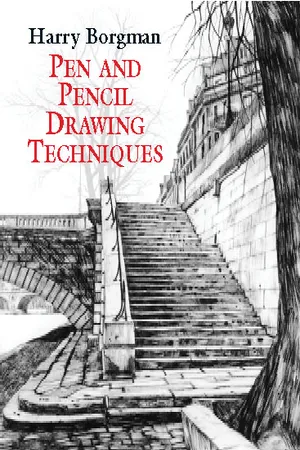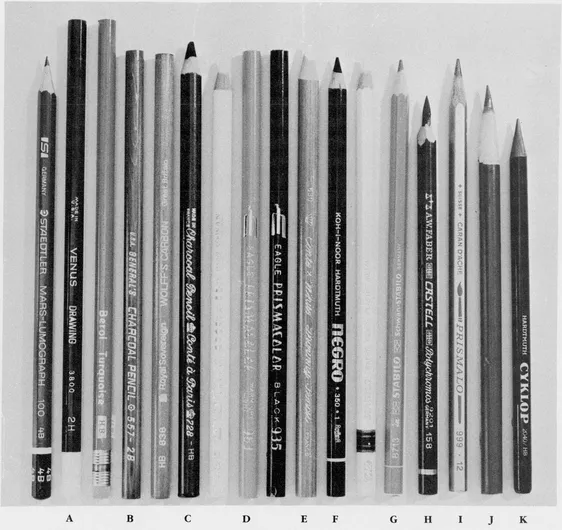For the beginning art student, the pencil is already a familiar tool, used for writing if not drawing. As a natural drawing instrument, it is simplicity itself. With a pencil and a sheet of paper, you are ready to start drawing.
Not only is there a variety of drawing pencils available to artists, but pencils can be used in so many ways. Just by sharpening the lead point differently, you can create distinctively drawn lines. And the various grades of lead, from very hard to very soft, produce even more variety, in both line and tone. You can create drawings by using only lines, by using tones devoid of lines, or by using any number of techniques in between.
Pencil is also compatible with a wide variety of paper surfaces, whose textures can add a great deal of interest to a drawing. These different papers broaden the drawing possibilities, since each surface responds differently to the pencil.
And, most important, the artist’s own imagination brings further possibilities to this truly marvelous medium.
IF YOU ARE SERIOUS about drawing, you will need to know about the many possibilities available in this medium. One way to gain more skill in your drawing, so that you can move from the simple to the complex, is to learn about your drawing tools and how to handle them. This chapter will tell you what the best materials are and how to use them. Just knowing your tools can give you a measure of confidence, which will reflect itself in your work.
PENCILS
Fortunately for artists and art students, there are a great variety of drawing pencils available, as well as many excellent paper surfaces to work on.
Graphite Pencils. The traditional basic drawing tool—the graphite pencil—is made of compressed graphite that is encased in cedarwood. It is available in many different grades, ranging from very hard to very soft. The order of grading is 9H, 8H, 7H, 6H, 5H, 4H, 3H, 2H, H, HB, B, 2B, 3B, 4B, 5B, and 6B. The 9H lead is the hardest grade, and the 6B is the softest. Personally I prefer using the HB grade for general work and often use the H and 2H grades as well. Experiment with a few of the different grades to see which you prefer. Generally speaking, the harder grades work better on smooth, hard-surface paper, and the softer grades work better on textured paper.
With regard to lead grades, the harder the lead, the lighter the line; the softer the lead, the darker the line. The harder grades—those above 2H are usually used for drafting or for mechanical drawing; the softer grades are used for general drawing. For sketching, the very soft grades—2B through 6B—are best; the hard 2H to B grades are better for meticulous renderings.
Many fine brands of graphite pencils are available, and you will have to try a few of them to see which you prefer. Some brands I have found to be excellent are Berol Eagle turquoise, Koh-I-Noor, Mars Lumograph, and Venus. Some graphite pencils especially suited for sketching have very broad, flat leads for drawing thick lines. These sketching pencils usually come in grades of 2B, 4B, and 6B. The Ebony pencil, which has a large diameter and a very black lead, is also quite good.
Charcoal and Carbon Pencils. There are many types of charcoal and carbon pencils on the market. A good brand is General Charcoal. It is a deep black and comes in grades of HB, 2B, 4B, 6B, and in white. Wolff carbon pencils are also quite good, and they come in grades of HH, H, HB, B, BB, and BBB, which is the softest.
Wax-Type Pencils. One of my favorite drawing pencils is the Koh-I-Noor Hardtmuth Negro pencil. It has a wax-type lead that is jet black, and it is available in five degrees of hardness. Many other wax-type pencils are on the market; some have very fine leads, whereas others have very soft, thick leads.
A. Graphite
B. Charcoal and carbon
C. Carb-Othello pastel
D. Berol Eagle turquoise Prismacolor
E. Conté white
F. Koh-I-Noor Hardtmuth Negro
G. Stabilo
H. Faber Castel Polychromos
I. Caran D’Ache Prismalo water-soluble
J. China marking pencils and litho crayons
K. Hardtmuth Cyklop
A. Pencil pointed with a sharpener
B. Sharpened with an X-Acto knife and a sanding block
C. Chisel-pointed with a sandpaper block
D. Two ways to sharpen charcoal pencils
E. Blunt point for beavier lines.
F. Graphite sticks with different drawing edges
G. Mechanical pencil for thin, even lines
I have used Berol Prismacolor pencils for many years and have found them to be uniform in color and lead consistency. Their leads are smooth, thick, and strong enough to sharpen to a fine point. Their color range is wide, comprising sixty colors. Prismacolor pencils can be purchased singly or in sets of 12, 24, 36, 48, or 60 colors. These pencils can also be used in conjunction with other mediums, such as markers, dyes, watercolors, and other painting mediums. They can be blended or smudged with a paper stump dampened with Bestine, a rubber-cement solvent.
China Marking Pencils. These pencils are available in several colors, including white, black, brown, red, blue, green, yellow, and orange. Stabilo, another wax-type pencil, is also available in eight colors.
Water-Soluble Pencils. Another interesting pencil is the Caran D’Ache water-soluble pencil. You can wash clear water over the drawn lines with a brush and dissolve the tones to create a pencil painting. You can also use Caran D’Ache pencils without dissolving the tones. This brand offers forty brilliant colors, whose strong leads can be sharpened to a fine point. Other types of water-soluble pencils are also available.
Pastels. These come in pencil form and are a very interesting medium to work with. They can be blended easily with your fingers or a paper stump and are especially suitable for soft effects. ...


